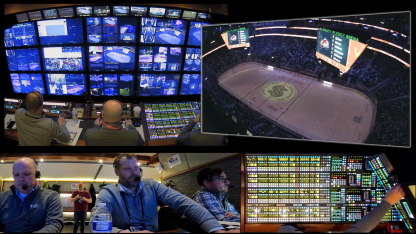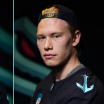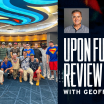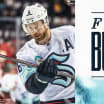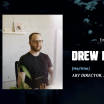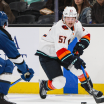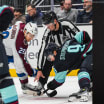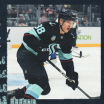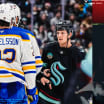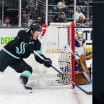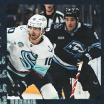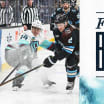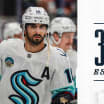The newly announced Kraken Hockey Network will debut as among the biggest, if not the biggest, regional broadcast production in the National Hockey League. But from top leadership – owner Samantha Holloway and CEO Tod Leiweke – and throughout the organization, that’s not the major reason why the Pacific Northwest will enjoy the most innovative, fan-forward hockey telecast this season and beyond.
“The whole point is not to brag that we're the biggest and best,” said Patrick Brown, director of all Kraken games this season, save the ten aired on TNT, ESPN or ABC. “The point here is to have more tools to tell the stories with. That's what we're here to do. We aim to figure out how we can tell these stories in the best ways and not get caught without angles or without the ability to tell any story we want to present to our viewers.”
Brown and Ryan Schaber, the Kraken’s new vice president for broadcast, move to KHN after teaming up as a dynamic duo (not an exaggeration), putting on Kraken games for ROOT Sports during the first three seasons of the franchise. Schaber will serve as the producer of Seattle games. Both are thrilled with the “What do you need?” and “How we do best for the fans?” approach from Kraken leadership in an era when regional broadcasts are wavering, to say the least.
From Concept to Game Broadcast in Five Months
Pardon the understatement, but now Kraken employees Schaber, Brown, pre-/post-game producer Scott Malone, editor Stu Vitue and on-air personality Piper Shaw, faced an enormous task since player exit day in mid-April. Building a new network essentially from scratch includes so many details. Here’s just a few: staffing some 35 men and women who work the game day cameras/replay machines/more, working with team branding experts on how to fully integrate in the broadcasts, reviewing why fans voted the Kraken broadcast No. 1 in a 2023 The Athletic fan survey and stayed top-two in this summer’s survey.
To all that, add hundreds of conversations with Kraken personnel about how to get better for the fans. Plus, not to be overlooked, there’s the exciting news that four million fans in Washington, Alaska and Oregon will have more access to games over on-air stations and streamer Prime at no additional costs through their existing basic cable and Prime streaming services.
The five months went quickly. The first KHN telecast is Sunday for the preseason opener against Calgary at Climate Pledge Arena. Schaber said he and Brown and the game day crew are ready.
“We're coming from a really high standard already, which is great,” said Schaber. “The challenge is how do you make great better? We have arguably the best talent group in the league; we have the biggest production for a local broadcast. We have the most resources to put toward it compared to the rest of the local broadcasts.
“One way we're going to make it better is by telling our brand story. That can be the separator. Naturally, there was a barrier between ROOT Sports and the Kraken, kind of a third party, right? Now that we're in-house, we have access to tell the stories in a different, deeper way. It's not always just the player's and coaches' stories. It's the stories of One Roof Foundation. It's the stories of Common Thread nights. It's the story of Jessica Campbell. It's stories which we're going to be able to tell [during game broadcasts and pre-/post and intermissions] to educate fans about the sport of hockey and the Kraken organization in unique ways.”
Inside the Innovations
Make no mistake, another form of innovation for fans is operating 13 cameras, including
five robotic cameras for multiple looks on every key play of the game. Four replay operators with five different super slow mo camera angles to delight fans with visuals to accompany in-the-moment analysis from former NHLers Eddie Olczyk and JT Brown.
Another tell-it-better upgrade are robo-cams for every home game featuring (literally) ice-level views of faceoffs, corner scrums, saves and let’s see-that-again shots on goal. More good stuff is pending: Potential plans for in-game interviews with new coach Dan Bylsma via headset with John Forslund/Eddie Olczyk/JT Brown during the preseason. Plus, fans will hear from assistant coaches Dave Lowry, Jessica Campbell and Bob Woods on-air at intermission and/or end of game for select regular season games.
Analyst Alison Lukan is back for a fourth season of providing her take on game action (this year in conversation with game anchor and local broadcast personality Ian Furness) along with her next-level, fan-friendly storytelling using hockey analytics data. Lukan remains the only analytics report among all 32 regional broadcasts and is the only female analyst on air who came up as a recreational player rather than being a member of a national team, pro squad and/or a star in NCAA hockey.
Going in Depth on Super Slow Mo
The Super Slow-Mo cameras are a game changer, said Brown, even more impactful than high-definition TV. Schaber concurs and notes a few teams have six super slow-mo cameras, and most clubs have fewer, and some teams have none, “which is crazy.”
Schaber explains his group will strive to serve up the sights and sounds via rink-board microphones to capture value-added audio such as skate blades cutting and edging through the ice, stick-puck sounds and stick-on-stick noises along with a clear indication of physicality of the body-on-body NHL. He wants fans to feel they are at the game. There is one thing he can’t convey with the cameras and sound equipment.
“A challenge with hockey is what doesn't get translated on TV is the tremendous speed of the game,” said Schaber. “Speed is something when you go in person for the first time; that's when you're like, wow, I didn't realize how these players are skating. It’s like watching the 100-meter dash in the Olympics. We have no idea just how incredibly fast those sprinters are going. Medals are decided by fractions of a second.”
In hockey, players succeed or fall short on an offensive rush because they need to decide in the same sort of fractional seconds if they have time and space to take a shot or if better to pass to a teammate or perhaps dump the puck so a new shift of fresh teammates can take over. The KHN production crew and talent will use super slow-mo replays to show how elite players make the right decisions in split-seconds.
“The visual part is, hey, we saw them do a move, or we saw that goal,” said Schaber. “The technology slows it down, and super slow-mo is where it really comes through to appreciate a truly athletic, high hockey IQ play. We are very strategic in putting the super slow at certain camera positions that we feel benefit fans the most from those angles.
“Part of what our crews do so well is the timing of replays. Sometimes, you do a real-time speed replay so you can see it all unfold. Sometimes, you do super slow-mo to see just how precisely the goal was scored or the save was made. Sometimes, we might do both. And then the audio really brings it to life.”
Both Schaber and Brown have many years of experience producing Sounders and MLS matches. Schaber said there is a similarity between how scoring chances unfold and, most especially, the sudden and exciting high-decibel fan reaction when a goal is scored.
Broadcast Game Call and Analysis Begets Ideal Camera Shots
Along with the Kraken fan base loving the work of the game broadcast trio of John Forslund, Eddie Olczyk and JT Brown (same for Lukan in her analyst role), Patrick Brown says Forslund’s game call and the analysis from two former NHLers is an underrated secret weapon of sorts.
One of the things I'm always telling camera operators, whether the home guys or the people we use on the road, is listen to the announcers,” said Brown. “That’s our number one job. If we can put up a picture that shows the evidence of what they're talking about, then we've already won."
Brown provided an example: “Something happens, play continues, the whistle blows, and Forslund and the analysts note [Adam] Larsson’s play in the defensive zone that set up the scoring chance. “That's where the camera operators we’ve selected are top-notch. When they hear the wind-up talking about Larsson, they're gonna go find him immediately for our use. They're listening and guided by the best in the business up in the booth.”
Slashing, Eddie Olczyk Style
Sometimes, innovation comes by an analyst uses certain camera angles to explain just how a play develops. For Eddie Olczyk, he works his next-level, no-one-else-does-it-that-good innovating with what Brown and colleagues call the “slash” camera.
“It’s a camera we use that stays pretty much wide to follow the action up and down,” said Brown. “That’s Edzo’s favorite camera. It's called the slash camera because it's kind of at a slash angle from the corner. Edzo actually has a monitor of that camera in the booth live, and he's watching that camera as much as anything.”
Brown said he knows of no other hockey analyst who advocates for such a monitor view, and certainly, none are the maestro that Olczyk is with the wide shot.
“We do a lot of testing our cameras before every game [especially with so many events at Climate Pledge Arena] that require breakdown and rebuild of the game broadcast equipment]," said Brown. “Edzo will tell me if that camera is not framed the way he likes it. I support what he wants. That's a camera to which we can always go back and find stuff because it's always going to have the entire play unfolding.”

